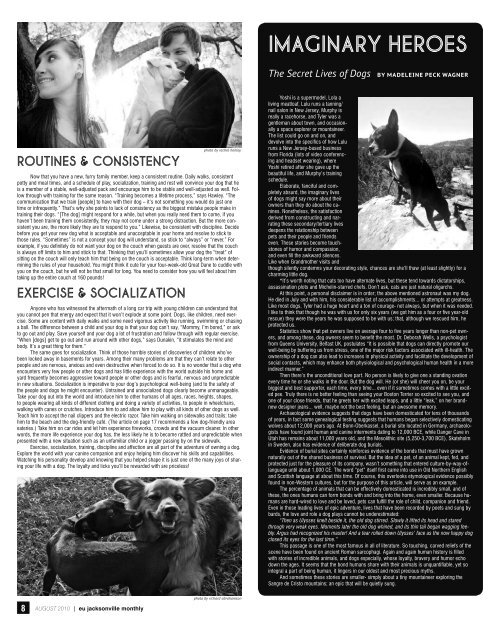EU_Page 1_COVER.indd - Eujacksonville.com
EU_Page 1_COVER.indd - Eujacksonville.com
EU_Page 1_COVER.indd - Eujacksonville.com
You also want an ePaper? Increase the reach of your titles
YUMPU automatically turns print PDFs into web optimized ePapers that Google loves.
ROUTINES & CONSISTENCY<br />
Now that you have a new, furry family member, keep a consistent routine. Daily walks, consistent<br />
potty and meal times, and a schedule of play, socialization, training and rest will convince your dog that he<br />
is a member of a stable, well-adjusted pack and encourage him to be stable and well-adjusted as well. Follow<br />
through with training for the same reason. “Training be<strong>com</strong>es a lifetime process,” says Hawley. “The<br />
<strong>com</strong>munication that we train [people] to have with their dog – it’s not something you would do just one<br />
time or infrequently.” That’s why she points to lack of consistency as the biggest mistake people make in<br />
training their dogs. “[The dog] might respond for a while, but when you really need them to <strong>com</strong>e, if you<br />
haven’t been training them consistently, they may not <strong>com</strong>e under a strong distraction. But the more consistent<br />
you are, the more likely they are to respond to you.” Likewise, be consistent with discipline. Decide<br />
before you get your new dog what is acceptable and unacceptable in your home and resolve to stick to<br />
those rules. “Sometimes” is not a concept your dog will understand, so stick to “always” or “never.” For<br />
example, if you defi nitely do not want your dog on the couch when guests are over, resolve that the couch<br />
is always off limits to him and stick to that. Thinking that you’ll sometimes allow your dog the “treat” of<br />
sitting on the couch will only teach him that being on the couch is acceptable. Think long-term when determining<br />
the rules of your household. You might think it cute for your four-week-old Great Dane to cuddle with<br />
you on the couch, but he will not be that small for long. You need to consider how you will feel about him<br />
taking up the entire couch at 160 pounds!<br />
EXERCISE & SOCIALIZATION<br />
Anyone who has witnessed the aftermath of a long car trip with young children can understand that<br />
you cannot pen that energy and expect that it won’t explode at some point. Dogs, like children, need exercise.<br />
Some are content with daily walks and some need vigorous activity like running, swimming or chasing<br />
a ball. The difference between a child and your dog is that your dog can’t say, “Mommy, I’m bored,” or ask<br />
to go out and play. Save yourself and your dog a lot of frustration and follow through with regular exercise.<br />
“When [dogs] get to go out and run around with other dogs,” says Dunakin, “it stimulates the mind and<br />
body. It’s a great thing for them.”<br />
The same goes for socialization. Think of those horrible stories of discoveries of children who’ve<br />
been locked away in basements for years. Among their many problems are that they can’t relate to other<br />
people and are nervous, anxious and even destructive when forced to do so. It is no wonder that a dog who<br />
encounters very few people or other dogs and has little experience with the world outside his home and<br />
yard frequently be<strong>com</strong>es aggressive toward people or other dogs and is fearful, nervous and unpredictable<br />
in new situations. Socialization is imperative to your dog’s psychological well-being (and to the safety of<br />
the people and dogs he might encounter). Untrained and unsocialized dogs clearly be<strong>com</strong>e unmanageable.<br />
Take your dog out into the world and introduce him to other humans of all ages, races, heights, shapes,<br />
to people wearing all kinds of different clothing and doing a variety of activities, to people in wheelchairs,<br />
walking with canes or crutches. Introduce him to and allow him to play with all kinds of other dogs as well.<br />
Teach him to accept the nail clippers and the electric razor. Take him walking on sidewalks and trails; take<br />
him to the beach and the dog-friendly café. (The article on page 17 re<strong>com</strong>mends a few dog-friendly area<br />
eateries.) Take him on car rides and let him experience fi reworks, crowds and the vacuum cleaner. In other<br />
words, the more life experience your dog has, the less likely he is to be<strong>com</strong>e rattled and unpredictable when<br />
presented with a new situation such as an unfamiliar child or a jogger passing by on the sidewalk.<br />
Exercise, socialization, training, discipline and affection are all part of the adventure of owning a dog.<br />
Explore the world with your canine <strong>com</strong>panion and enjoy helping him discover his skills and capabilities.<br />
Watching his personality develop and knowing that you helped shape it is just one of the many joys of sharing<br />
your life with a dog. The loyalty and licks you’ll be rewarded with are priceless!<br />
8 AUGUST 2010 | eu jacksonville monthly<br />
photo by rachel henley<br />
photo by richard abrahamson<br />
IMAGINARY HEROES<br />
The Secret Lives of Dogs BY MADELEINE PECK WAGNER<br />
Yoshi is a supermodel, Lola a<br />
living meatloaf, Lulu runs a tanning/<br />
nail salon in New Jersey, Murphy is<br />
really a racehorse, and Tyler was a<br />
gentleman about town, and occasionally<br />
a space explorer or mountaineer.<br />
The list could go on and on, and<br />
devolve into the specifi cs of how Lulu<br />
runs a New Jersey-based business<br />
from Florida (lots of video conferencing<br />
and headset wearing), where<br />
Yoshi retired after she gave up the<br />
beautiful life, and Murphy’s training<br />
schedule.<br />
Elaborate, fanciful and <strong>com</strong>pletely<br />
absurd, the imaginary lives<br />
of dogs might say more about their<br />
owners than they do about the canines.<br />
Nonetheless, the satisfaction<br />
derived from constructing and narrating<br />
these secondary/tertiary lives<br />
deepens the relationship between<br />
pets and their people and friends<br />
even. These stories be<strong>com</strong>e touchstones<br />
of humor and <strong>com</strong>passion,<br />
and even fi ll the awkward silences.<br />
Like when Grandmother visits and<br />
though silently condemns your decorating style, chances are she’ll thaw (at least slightly) for a<br />
charming little dog.<br />
*It’s worth noting that cats too have alternate lives, but these tend towards dictatorships,<br />
assassination plots and Michelin-starred chefs. Don’t ask, cats are just natural oligarchs.<br />
At this point, a personal disclaimer is in order; the above mentioned astronaut was my dog.<br />
He died in July and with him, his considerable list of ac<strong>com</strong>plishments... or attempts at greatness.<br />
Like most dogs, Tyler had a huge heart and a ton of courage- not always, but when it was needed.<br />
I like to think that though he was with us for only six years (we got him as a four or fi ve year-old<br />
rescue) they were the years he was supposed to be with us; that, although we rescued him, he<br />
protected us.<br />
Statistics show that pet owners live on average four to fi ve years longer than non-pet owners,<br />
and among these, dog owners seem to benefi t the most. Dr. Deborah Wells, a psychologist<br />
from Queens University, Belfast UK, postulates “It is possible that dogs can directly promote our<br />
well-being by buffering us from stress, one of the major risk factors associated with ill-health. The<br />
ownership of a dog can also lead to increases in physical activity and facilitate the development of<br />
social contacts, which may enhance both physiological and psychological human health in a more<br />
indirect manner.”<br />
Then there’s the unconditional love part. No person is likely to give one a standing ovation<br />
every time he or she walks in the door. But the dog will. He (or she) will cheer you on, be your<br />
biggest and best supporter, each time, every time... even if it sometimes <strong>com</strong>es with a little excited<br />
pee. Truly there is no better feeling than seeing your Boston Terrier so excited to see you, and<br />
one of your close friends, that he greets her with excited leaps, and a little “leak,” on her brandnew<br />
designer jeans... well, maybe not the best feeling, but an awesome memory.<br />
Archaeological evidence suggests that dogs have been domesticated for tens of thousands<br />
of years, in fact some genealogical testing suggests that humans began selectively domesticating<br />
wolves about 12,000 years ago. At Bonn-Oberkassel, a burial site located in Germany, archaeologists<br />
have found joint human and canine interments dating to 12,000 BCE, while Danger Cave in<br />
Utah has remains about 11,000 years old, and the Mesolithic site (5,250-3,700 BCE), Skateholm<br />
in Sweden, also has evidence of deliberate dog burials.<br />
Evidence of burial sites certainly reinforces evidence of the bonds that must have grown<br />
naturally out of the shared business of survival. But the idea of a pet, of an animal kept, fed, and<br />
protected just for the pleasure of its <strong>com</strong>pany, wasn’t something that entered culture-by-way-oflanguage<br />
until about 1,000 CE. The word “pet” itself fi rst came into use in Old Northern English<br />
and Scottish language at about this time. Of course, this overlooks etymological evidence possibly<br />
found in non-Western cultures, but for the purpose of this article, will serve as an example.<br />
The percentage of animals that can be effectively domesticated is incredibly small, and of<br />
these, the ones humans can form bonds with and bring into the home, even smaller. Because humans<br />
are hard-wired to love and be loved, pets can fulfi ll the role of child, <strong>com</strong>panion and friend.<br />
Even in those leading lives of epic adventure, lives that have been recorded by poets and sung by<br />
bards, the love and role a dog plays cannot be underestimated:<br />
“Then as Ulysses knelt beside it, the old dog stirred. Slowly it lifted its head and stared<br />
through very weak eyes. Moments later the old dog whined, and its thin tail began wagging feebly.<br />
Argus had recognized his master! And a tear rolled down Ulysses’ face as the now happy dog<br />
closed its eyes for the last time.”<br />
This passage is one of the most famous in all of literature. So touching, carved reliefs of the<br />
scene have been found on ancient Roman sarcophagi. Again and again human history is fi lled<br />
with stories of incredible animals, and dogs especially, whose loyalty, bravery and humor echo<br />
down the ages. It seems that the bond humans share with their animals is unquantifi able, yet so<br />
integral a part of being human, it lingers in our oldest and most precious myths.<br />
And sometimes these stories are smaller- simply about a tiny mountaineer exploring the<br />
Sangre de Cristo mountains; an epic that will be quietly sung.
















